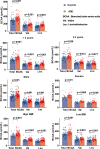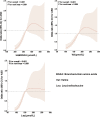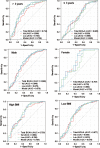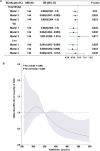The Association Between Branched-Chain Amino Acid Concentrations and the Risk of Autism Spectrum Disorder in Preschool-Aged Children
- PMID: 38265552
- PMCID: PMC11249470
- DOI: 10.1007/s12035-024-03965-4
The Association Between Branched-Chain Amino Acid Concentrations and the Risk of Autism Spectrum Disorder in Preschool-Aged Children
Abstract
Several studies have linked branched-chain amino acid (BCAA) metabolism disorders with autism spectrum disorder (ASD), but the results have been inconsistent. The purpose of this study was to explore the association between BCAA concentrations and the risk of ASD. A total of 313 participants were recruited from two tertiary referral hospitals from May 2018 to July 2021. Concentrations of BCAAs in dried blood spots were analyzed using liquid chromatography-tandem mass spectrometry-based analysis. Multivariate analyses and restricted cubic spline models were used to identify the association between BCAAs and the risk of ASD, and a nomogram was developed by using multivariate logistic regression and the risk was determined by receiver operating characteristic curve analysis and calibration curve analysis. Concentrations of total BCAA, valine, and leucine/isoleucine were higher in the ASD group, and all of them were positively and non-linearly associated with the risk of ASD even after adjusting for potential confounding factors such as age, gender, body mass index, and concentrations of BCAAs (P < 0.05). The nomogram integrating total BCAA and valine showed a good discriminant AUC value of 0.756 (95% CI 0.676-0.835). The model could yield net benefits across a reasonable range of risk thresholds. In the stratified analysis, the diagnostic ability of the model was more pronounced in children older than 3 years. We provide evidence that increased levels of BCAAs are associated with the risk of ASD, and the nomogram model of BCAAs presented here can serve as a marker for the early diagnosis of ASD.
Keywords: Autism spectrum disorders; Branched-chain amino acids; Early diagnosis; Nomogram; Preschool children.
© 2024. The Author(s).
Conflict of interest statement
The authors declare no competing interests.
Figures





Similar articles
-
Associations between amino acid levels and autism spectrum disorder severity.BMC Psychiatry. 2025 Apr 4;25(1):332. doi: 10.1186/s12888-025-06771-x. BMC Psychiatry. 2025. PMID: 40186136 Free PMC article.
-
Maternal Obesity/Diabetes, Plasma Branched-Chain Amino Acids, and Autism Spectrum Disorder Risk in Urban Low-Income Children: Evidence of Sex Difference.Autism Res. 2019 Oct;12(10):1562-1573. doi: 10.1002/aur.2177. Epub 2019 Aug 9. Autism Res. 2019. PMID: 31400063 Free PMC article.
-
Short-Term Effects of Branched-Chain Amino Acids-Enriched Dialysis Fluid on Branched-Chain Amino Acids Plasma Level and Mass Balance: A Randomized Cross-Over Study.J Ren Nutr. 2020 Jan;30(1):61-68. doi: 10.1053/j.jrn.2019.03.079. Epub 2019 May 8. J Ren Nutr. 2020. PMID: 31078402 Clinical Trial.
-
The role of skeletal muscle in the pathogenesis of altered concentrations of branched-chain amino acids (valine, leucine, and isoleucine) in liver cirrhosis, diabetes, and other diseases.Physiol Res. 2021 Jul 12;70(3):293-305. doi: 10.33549/physiolres.934648. Epub 2021 May 12. Physiol Res. 2021. PMID: 33982576 Free PMC article. Review.
-
Association of circulating branched-chain amino acids with risk of cardiovascular disease: A systematic review and meta-analysis.Atherosclerosis. 2022 Jun;350:90-96. doi: 10.1016/j.atherosclerosis.2022.04.026. Epub 2022 Apr 25. Atherosclerosis. 2022. PMID: 35576716
Cited by
-
Associations between amino acid levels and autism spectrum disorder severity.BMC Psychiatry. 2025 Apr 4;25(1):332. doi: 10.1186/s12888-025-06771-x. BMC Psychiatry. 2025. PMID: 40186136 Free PMC article.
-
Modifiable Nutritional Biomarkers in Autism Spectrum Disorder: A Systematic Review and Meta-Analysis of Vitamin D, B12, and Homocysteine Exposure Spanning Prenatal Development Through Late Adolescence.Int J Mol Sci. 2025 May 6;26(9):4410. doi: 10.3390/ijms26094410. Int J Mol Sci. 2025. PMID: 40362647 Free PMC article. Review.
-
BCKDK loss impairs mitochondrial Complex I activity and drives alpha-synuclein aggregation in models of Parkinson's disease.Acta Neuropathol Commun. 2024 Dec 21;12(1):198. doi: 10.1186/s40478-024-01915-8. Acta Neuropathol Commun. 2024. PMID: 39709505 Free PMC article.
References
MeSH terms
Substances
LinkOut - more resources
Full Text Sources
Medical

